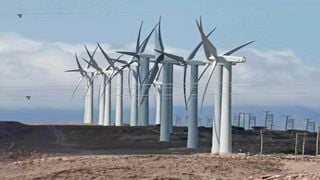
Wind turbines at the Lake Turkana Wind Power project on July 19, 2019.
| File | Nation Media GroupBusiness
Premium
How the chase for cheaper power from Lake turkana project turned elusive
What you need to know:
- Reliance on expensive thermal energy was over 40 percent, geothermal was not as significant and hydro was too weather-reliant to guarantee steady supply.
- The Sh70 billion project would not only inject clean power into the grid but was also billed as a cheaper option for the country whose consumers were constantly demanding cheaper electricity.
In 2011 when whispers of a wind power project in Kenya began to get louder, the country was struggling with its generation mix.
Reliance on expensive thermal energy was over 40 percent, geothermal was not as significant and hydro was too weather-reliant to guarantee steady supply.
Five days before Christmas of 2014, a financial closure was reached and Kenya was on the path to hosting Africa’s largest wind power facility.
The Sh70 billion project would not only inject clean power into the grid but was also billed as a cheaper option for the country whose consumers were constantly demanding cheaper electricity.
Kenya’s Least Cost Power Development Plan used in the project’s feasibility documents even said the wind farm would ‘generate the lowest cost power available to Kenya, which is 60 percent less expensive than the emergency thermal power plants.’
The 310 megawatts Lake Turkana Wind Power project may have delivered the cleaner energy for the country but the dream of reducing the cost of power remains elusive and its last two years of operation have left stakeholders chasing the wind in pursuit of cheaper power.
Electricity not used
Data from the Energy and Petroleum Regulatory Authority shows that the weighted average cost of power from the wind sources rank second after thermal to retail at Sh11.21 per unit with the currently reduced Value Added Tax of 14 percent.
The cost is Sh6.7 or 38 percent cheaper than thermal plants Kenya is keen on switching off and is far from the projected 60 percent relief from the expensive diesel as had been projected.
The cost of the project for Kenya was behind the exit of the World Bank whose concern was both on the country’s ability to absorb the power the plant was designed to generate and its impact on the cost of energy.
The global lender also withdrew its guarantees for the project after a sales deal with Kenya Power committed that forces consumers to pay billions of shillings for electricity not used — effectively beating the project’s primary purpose on the same.
The take-or-pay provisions in the deal would expose Kenya Power to ‘unacceptably large financial risk’ after it was committed to paying for excess power from the wind farm, beating the logic of putting up the wind farm to reduce the high cost of power.
The World Bank was also concerned about the deal clauses that put penalties on Kenya Power if the plant was completed before the transmission line would be ready to evacuate power.
Blown off
The project went on after the fall out and true to the concerns; Kenya was left with a Sh14.6 billion penalty when the line was not ready to evacuate power after lengthy delay foreseen by the World Bank.
“The PPA included contractual implications for both LTWP and Kenya Electricity Transmission Company in the event that either entity did not deliver the wind farm or the transmission interconnector respectively on time.
Based on this contractual agreement LTWP has only received Sh5.7 Billion of the Sh14.6 Billion that it is owed by KPLC for this delay and is not charging interest for the balance whose payment has been deferred over a 6-year period,” LTWP writes on its website.
Analysts believe it was a set up. Kenya power was only left with a buffer of three months since the construction of the transmission line was expected to take 23 months while that of the power plant was estimated at 26 months.
With that clause, the cheaper power element was blown off and the current tariff which is supposed to run for the first six years carries the load of the penalty which is expected to ease after the seventh year when the wind power will be sold at 7.684 euro cents (Sh9.91) per unit.
The firm had offered to sell power at half the rate once Kenya begins to absorb its output beyond a certain threshold.
Agreed capacity factor
This too has remained elusive since what is taken by Kenya Power is dependent on what LTWP gives and the wind is also unpredictable like it happened last year.
Recent Kenya Power records show that LTWP earned Sh11.05 billion as sales revenues for supplying electricity to it in the 10 months to June last year, the third largest power purchase costs incurred by the utility firm, after Kenya Electricity Generating Company (Sh36.89 billion) and OrPower 4 Inc (Sh12.58 billion).
The project supplied 1,124-gigawatt hours (GWh) to the national grid during the review period, in contrast with KenGen’s 8,276 GWh.
The earnings are despite the wind power firm reporting on its latest sustainability report that it was yet to hit the agreed capacity factor of 62 percent having maintained its capacity factor of 57 percent in the first year of operation.
The project is also yet to contribute the 20 percent generation mix that was envisioned with the average contribution over the past year at 11 percent.
LTWP says since its connection to the national grid on 24 September 2018, the Wind Farm had injected into the grid in excess of 1.8b kWh of clean, renewable energy by December 2019 and paid some Sh264 million in direct taxes to the Kenyan government.





